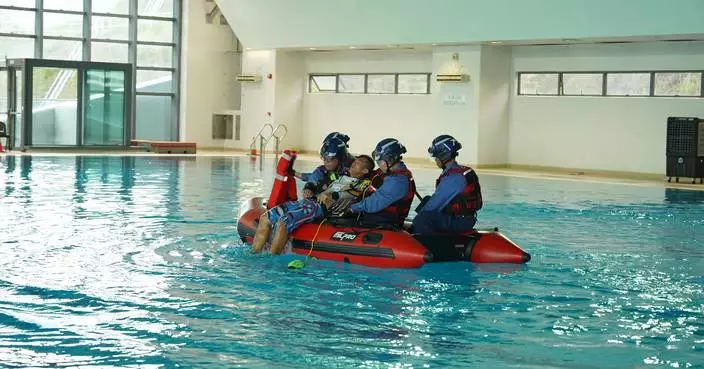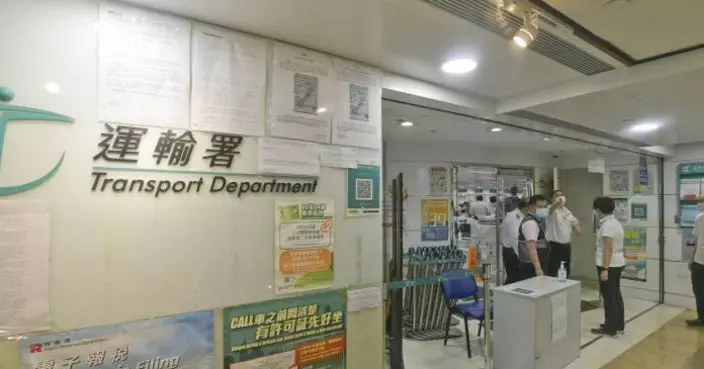Exciting update: latest exchange fund bills tender results revealed!
The following is issued on behalf of the Hong Kong Monetary Authority:
Exchange Fund Bills tender results:
Tender date
:
May 7, 2024
Paper on offer
:
EF Bills
Issue number
:
Q2419
Issue date
:
May 8, 2024
Maturity date
:
August 7, 2024
Amount applied
:
HK$152,110 MN
Amount allotted
:
HK$59,077 MN
Average yield accepted
:
4.20 PCT
Highest yield accepted
:
4.24 PCT
Pro rata ratio*
:
About 34 PCT
Average tender yield
:
4.30 PCT
****************************
Tender date
:
May 7, 2024
Paper on offer
:
EF Bills
Issue number
:
H2448
Issue date
:
May 8, 2024
Maturity date
:
November 6, 2024
Amount applied
:
HK$61,368.0 MN
Amount allotted
:
HK$17,000 MN
Average yield accepted
:
4.21 PCT
Highest yield accepted
:
4.25 PCT
Pro rata ratio*
:
About 58 PCT
Average tender yield
:
4.38 PCT
****************************
Tender date
:
May 7, 2024
Paper on offer
:
EF Bills
Issue number
:
Y2489
Issue date
:
May 8, 2024
Maturity date
:
May 7, 2025
Amount applied
:
HK$14,030 MN
Amount allotted
:
HK$3,000 MN
Average yield accepted
:
4.13 PCT
Highest yield accepted
:
4.20 PCT
Pro rata ratio*
:
About 9 PCT
Average tender yield
:
4.31 PCT
*"Pro rata ratio" refers to the average percentage of allotment with respect to each tender participant’s tendered amount at the "highest yield accepted" level.
---------------------------------------------------------
Hong Kong Monetary Authority tenders to be held in the week beginning May 13, 2024:
Tender date
:
May 14, 2024
Paper on offer
:
EF Bills
Issue number
:
Q2420
Issue date
:
May 16, 2024
Maturity date
:
August 14, 2024
Tenor
:
90 Days
Amount on offer
:
HK$60,967 MN
****************************
Tender date
:
May 14, 2024
Paper on offer
:
EF Bills
Issue number
:
H2449
Issue date
:
May 16, 2024
Maturity date
:
November 13, 2024
Tenor
:
181 Days
Amount on offer
:
HK$19,000 MN

Source: AI-generated images
Epd addresses concerns raised on eia report for san tin/lok ma chau development node
âThe Environmental Protection Department (EPD) approved the Environmental Impact Assessment (EIA) report for San Tin/Lok Ma Chau Development Node (ST/LMC DN) with conditions. Regarding the questions raised by individual groups, the EPD responded today (May 19).
A spokesperson for the EPD said that the EIA process is scientific and professional. The Environmental Impact Assessment Ordinance (EIAO) and its Technical Memorandum (TM) have laid down scientific and objective standards and requirements, with designated professional authorities to help comprehensively review all EIA reports. The EIA process is also open and transparent. Starting from the submission of the project profile by the project proponent, all steps are made public on the EIAO website, and there is a two-stage consultation during the public inspection period to allow the public and the Advisory Council on the Environment (ACE) to fully express their comments. The Director of Environmental Protection (DEP) will approve the EIA report after fully considering all the above information and comments and confirming that the EIA report has met all statutory standards and requirements.
ã
Regarding the EIA report of the ST/LMC DN, the DEP explained in detail the basis for the approval at a press conference on May 17. For the comments raised by individual groups, the EPD provided consolidated responses on seven aspects:
(1) Validity of EIA Study Brief
The TM lays down clear guidelines on the requirements of the EIA Study Brief (SB): "The EIA SB aims to set out the purposes and objectives of the EIA study, the scope of environmental issues which shall be addressed, the requirements that the EIA study shall need to fulfil, and the necessary procedural and reporting requirements." Annex 3 of the TM also lists out all factors need to be considered. The EPD confirmed that, with regards to the provisions in the TM, the SB has covered all environmental issues that need to be assessed and met all relevant requirements.
(2) Ecological baseline survey and ecological impact
The key objectives of ecological surveys are to fill in information gaps in the existing available ecological information, and to confirm and evaluate the ecological value of habitats and species. There is a large amount and continuous ecological information within the study area, which includes the nature conservation management agreements undertaken by the Hong Kong Bird Watching Society funded by the Environment and Conservation Fund since 2012 as well as a number of EIA studies and environmental monitoring and audit reports. Relevant information has been appropriately taken into consideration in the EIA study.
(3) Avoid major environmental impacts as a priority
The EIA report has followed the principle in the order of "avoidance", "minimisation" and "compensation" in accordance with the requirements of the TM, such as avoiding the Ramsar Site, preservation of the core area of the Mai Po Lung Village Egretry and the Mai Po Village Egretry, as well as the mature woodland habitat at Pang Loon Tei, etc.
(4) Impacts on flight of breeding egrets and other wetland avifauna
A 12-month ecological baseline survey has been conducted under the EIA study in accordance with the requirements of the TM and the relevant guidance notes, which included surveys on flight paths above egretries and night roosts. The ecological impact assessment has also considered the indirect impacts imposed on the egrets and herons due to loss of foraging grounds or disturbance.
The EIA report also recommended designation of non-building area and stringent building height restriction for preservation of a 300-metre-wide (comparable with the width of the Tsing Yi North Bridge) east-west birds' flight corridor; preservation of a 70m-wide bird flight path of the Mai Po Lung Village Egretry. The Tuen Mun River currently passing through the Tuen Mun Park (one of the top ten roosting sites in Hong Kong), which serves as a flight path frequently used by egrets, has a width of only 75m, and therefore it is sufficient to serve as a flight path for egrets.
(5) Impacts on Euraisan otters and design details of wildlife corridors
Based on literature records (otter scats instead of otters were found in the area), the EIA report has assumed that otters are present and conducted corresponding assessment. After listening to the views of green groups and the ACE and making reference to Taiwan's experience in protecting Eurasian otters, enhancement measures that are conducive to otters' activities were proposed, including establishing 10m-wide above ground wildlife corridors with water environment; underground wildlife corridors with cross-sectional area no less than six square meters with natural lighting; widening of the gaps in the grille of the water channel connecting the Shenzhen River; and adding otter-specific ladders or passages at the dam of the main drainage channel and the flap valve.
(6) Effectiveness of wetland compensation
The EIA report has made reference to the actual experience of the Sheung Shui to Lok Ma Chau Spur Line construction works, and proposed enhancement of ecological function and capacity of the fish pond wetlands through active management, and proved the effectiveness of wetland compensation with facts. The EIA report recommended adopting a variety of measures, including consolidating smaller and scattered fish ponds into larger water bodies, setting up artificial habitat islands, reprofiling of pond banks, pond drain-down, and when necessary, trash fish-stocking, to create and enhance environmental quality and capacity. The Hong Kong Bird Watching Society's website also pointed out that by adopting pond drain-down only can already increase the bird abundance by as much as 19 times. The current EIA report has only conservatively assumed a 45 per cent increase, which is sufficient to compensate for the ecological impact caused by the development of the San Tin Technopole.
(7) Mitigation and compensation and Habitation Creation and Management Plan
The EIA report has devised mitigation measures for potential ecological impacts during the construction period, including installing noise barriers at the boundaries of the construction area and carrying out construction in phases outside the period of arrival of migratory birds, supplemented by corresponding environmental monitoring requirements to reduce ecological impacts during construction.
The Civil Engineering and Development Department (CEDD) will also implement a series of wetland enhancement measures at Mai Po, including desilting of tidal channels connecting the gei wai of the Mai Po Nature Reserve and the Inner Deep Bay, so as to improve water exchange in the gei wai thereby increasing the number of fish and shrimps for migratory birds to forage. Part of the exotic mangrove invading the mudflat of the Inner Deep Bay will also be cleared to increase the feeding and habitat space for migratory birds. In addition, the CEDD will implement interim wetland enhancement measures, including restoration of abandoned ponds in the Inner Deep Bay area and active management of the restored ponds including trash fish stocking. Furthermore, no pond filling works of the project will be commenced prior to commencement of construction of the ecologically enhanced fish ponds.
The CEDD has submitted the Draft Habitat Creation and Management Plan upon request of the ACE, and will set up an Environmental Committee comprising representatives from relevant government departments, green groups and academics to advise on the preparation of various implementation plans.
Conclusion
The EIA process is scientific, professional and comprehensive. The EPD has fully considered comments received during the public inspection of the EIA report and consulted relevant authorities in accordance with the TM. The ACE also unanimously approved the EIA report and its recommendations. The EPD hopes to optimise the project through the EIA process so that the ST/LMC DN can improve its ecological environment and become a sustainable, livable place where urban and rural areas and nature integrate.

Source: AI-generated images











